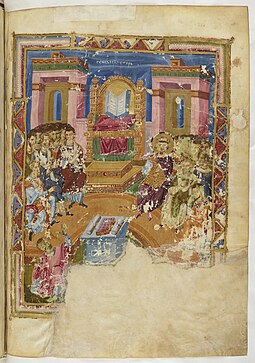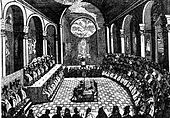| First Council of Constantinople | |
|---|---|
 9th century Byzantine manuscript illumination of I Constantinople. Homilies of St. Gregory of Nazianzus, 879–883. | |
| Date | 381 |
| Accepted by | |
Previous council | First Council of Nicaea |
Next council | Council of Ephesus |
| Convoked by | Emperor Theodosius I |
| President | Timothy of Alexandria, Meletius of Antioch, Gregory Nazianzus, and Nectarius of Constantinople |
| Attendance | 150 (no representation of Western Church) |
| Topics | Arianism, Holy Spirit |
Documents and statements | Nicene Creed of 381, seven canons (three disputed) |
| Chronological list of ecumenical councils | |
| Part of a series on the |
| Ecumenical councils of the Catholic Church |
|---|
 |
| 4th–5th centuries |
| 6th–9th centuries |
| 12th–14th centuries |
| 15th–16th centuries |
| 19th–20th centuries |
|
|
The First Council of Constantinople (Latin: Concilium Constantinopolitanum; ‹See Tfd›Greek: Σύνοδος τῆς Κωνσταντινουπόλεως) was a council of Christian bishops convened in Constantinople (now Istanbul, Turkey) in AD 381 by the Roman Emperor Theodosius I.[1][2] This second ecumenical council, an effort to attain consensus in the church through an assembly representing all of Christendom, except for the Western Church,[3] confirmed the Nicene Creed, expanding the doctrine thereof to produce the Niceno-Constantinopolitan Creed, and dealt with sundry other matters. It met from May to July 381[4] in the Church of Hagia Irene and was affirmed as ecumenical in 451 at the Council of Chalcedon.
- ^ Socrates Scholasticus, Church History, book 5, chapters 8 & 11, puts the council in the same year as the revolt of Magnus Maximus and death of Gratian.
- ^ Hebblewhite, M. (2020). Theodosius and the Limits of Empire. pp. 56ff.
- ^ Richard Kieckhefer (1989). "Papacy". Dictionary of the Middle Ages. ISBN 0-684-18275-0.
- ^ "Catholic Encyclopedia: First Council of Constantinople". www.newadvent.org. Retrieved 2021-06-02.